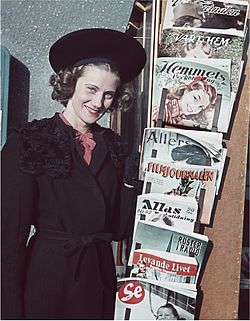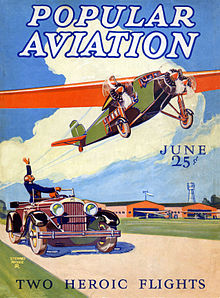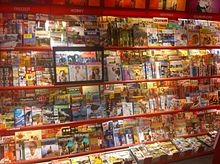Magazine
A magazine, magazine or magazín (from English magazine, and this from French magazine) is a public or private periodical publication. Unlike newspapers or newspapers, which are mainly oriented to transmit news, magazines offer a somewhat more exhaustive treatment of the events or topics they develop, which can be current affairs or entertainment, whether of a show business, cinematographic, scientific, artistic, among others. They are usually printed on better quality paper, with a more careful binding and more space for graphic documentation. Depending on the topic on which the magazine focuses, it will bring content that is supposed to be of general interest to the public of these publications.
History
It can be considered as an antecedent of the "magazine" the appearance of periodical publications in the form of almanacs, which were not only informative but also incorporated into their pages a variety of material considered to be of interest to readers.
One of the first was the German publication Erbauliche Monaths-Unterredungen(Edifying Monthly Discussions), which appeared between 1663 and 1668. Others soon appeared with certain periodicity in countries such as France, England and Italy. As early as the 1670s, some light content or entertainment magazines were made known to the public. Le Mercure Galant, published in 1672 —and which later changed its name to Mercure de France—, was one of the best known. For their part, Joseph Addison and Richard Steele created the magazine The Tatler (1709-1711) in Great Britain, published three times a week.
As magazine consumption became more specialized and diversified, publishing became more profitable than newspapers, even though both come from a similar background.
Types
The magazines can be classified according to various variables: according to their theme (religious, sports, entertainment, cooking, travel, decoration, dissemination or politics), by social segments (for children, youth, adults, groups of gender) or professional fields (scientists, law, business) and so on.
Magazine Printing
Magazines are usually printed on glossy paper so that the images look good. The grammage of the inner sheets must be in a paper lower than the cover around 115 and 150 grams, for the 300 cover it is the standard grammage. In addition, it is laminated in gloss to give the material greater durability and consistency.
There are also two ways to glue the sheets to the cover. For a few pages no larger than 80, it can be sewn to the spine with hooks since they resist up to this amount. For larger quantities, the leaves can be glued to the spine with hotmelt.
Internet magazines
The online magazine is often based on editions also published on paper, but the appearance of magazines published through digital media is an increasingly frequent modality. With this format, interactive functions with the public are added, for example, through the inclusion of discussion sections and the link to external sources and media.
A wide variety of magazines monetize their audience through Internet advertising insertion and e-commerce agreements, or through paid subscriptions.
Spanish magazines on the Internet
The Spanish magazine La garlanda polar, published in 1996, coined the term red-magazine for this type of publication, in discussion with the Urgent Spanish group of the EFE news agency.[citation required] In 2002, the publishing group Hachette Filipacchi began digitizing its magazines, a trend that was also joined by some of the main Spanish publishing groups, such as RBA Revistas, G+J, Grupo Zeta. This included the magazines ¡HOLA! or Pronto, which are historically the best sellers in Spain.
Varieties
Aimed at women
Fashion
In the 1920s, new magazines appealed to young German women with a sultry image and advertisements for the appropriate clothing and accessories they would want to buy. The glossy pages of Die Dame and Das Blatt der Hausfrau depicted the "Neue Frauen", "New Girl", what the Americans called it the flapper. This ideal young woman was stylish, financially independent, and an avid consumer of the latest trends. Magazines kept her up to date on fashion, art, sports, and modern technology such as cars and telephones.
Motherhood
The first women's magazine for wives and mothers was published in 1852. Through the use of advice columns, advertisements, and various parenting-related publications, women's magazines have influenced views on motherhood and parenting. children. Wide-circulation women's magazines have shaped and transformed cultural values related to parenting practices. As such, women's and motherhood magazines have exerted power and influence over ideas about motherhood and parenting.
Religion
Religious groups have used magazines to disseminate and communicate religious doctrine for more than 100 years. The Friend was founded in Philadelphia in 1827 at the time of a major Quaker schism; it has been published continuously and was renamed Friends Journal when rival Quaker groups formally reconciled in the mid-1950s.
Various Catholic magazines launched in the early 20th century that are still in circulation include; St. Anthony Messenger founded in 1893 and published by the Los Angeles-based Franciscan Friars (OFM) of St. John the Baptist Province, Cincinnati, Ohio, Tidings, founded in 1895 (renamed Angelus] in 2016), and published jointly by The Tidings Corporation and the Roman Catholic Archdiocese of Los Angeles, and Maryknoll, founded in 1907 by the Foreign Mission Society of America which brings news about the organization's charitable and missionary work in more than 100 countries. More than 100 Catholic magazines are published in the United States, and thousands worldwide, ranging from inspirational messages to individual religious orders, to the family life of the faithful, to global issues facing the Church around the world. world.
The flagship magazine of Jehovah's Witnesses, The Watchtower, was started by Charles Taze Russell in July 1879 under the title Zion's Watchtower and Herald of Christ's Presence. The public edition of the magazine is one of the most widely distributed in the world, with an average circulation of approximately 36 million per issue.
Celebrities, Human Interest, and Gossip
Magazines publishing stories and photos of high-profile individuals and celebrities have long been a popular format in the United States. In 2019, People Magazine was ranked second behind ESPN Magazine. in total reach with a reported reach of 98.51 million.
Professional
Professional magazines, also called trade magazines, or business-to-business are aimed at readers employed in specific industries. These magazines usually cover industry trends and news of interest to industry professionals. Memberships are often accompanied by membership in a professional association. Professional magazines may earn revenue from the insertion of advertisements or advertorials from companies that sell products and services to a specific professional audience. Some examples are Advertising Age and Automotive News.
Distribution
Print magazines may be distributed through the mail, through sales at newsstands, bookstores, or other vendors, or through free distribution at select pickup locations. Electronic distribution methods may include social media, email, news aggregators, and website visibility and search engines of a publication. Traditional subscription-to-distribution business models fall into three main categories:
Paid circulation
In this model, the magazine is sold to readers for a price, either by issue or by subscription, where you pay an annual fee or a monthly price and issues are mailed to readers. Paid circulation allows for defined readership statistics.
Unpaid circulation
This means there is no cover price and the issues are given away, for example, at street vendors, airlines, or bundled with other products or publications. Because this model involves giving away numbers to non-specific populations, the statistics only include the number of numbers distributed, not who reads them.
Controlled circulation
This is the model used by many trade magazines (industry-based periodicals) that are distributed only to qualified readers, often free of charge and determined by some form of survey. Due to the costs (eg, printing and postage) associated with print media, publishers cannot distribute free copies to everyone who asks (unqualified leads); instead, they operate with controlled circulation, deciding who can receive free subscriptions based on each person's qualification as an industry member (and probability of purchase, for example, probability of having corporate purchasing authority, determined from title).. This allows for a high level of certainty that ads will be received by the advertiser's target audience, and avoids wasteful printing and distribution costs. This last model was used long before the rise of the World Wide Web and is still used by some publishers. For example, in the UK, several magazines in the computer industry use this model, such as Computer Weekly and Computing, and in finance, Waters Magazine. In the global media sector, an example would be VideoAge International.
Contenido relacionado
Morocco flag
Ball
Breakbeat





